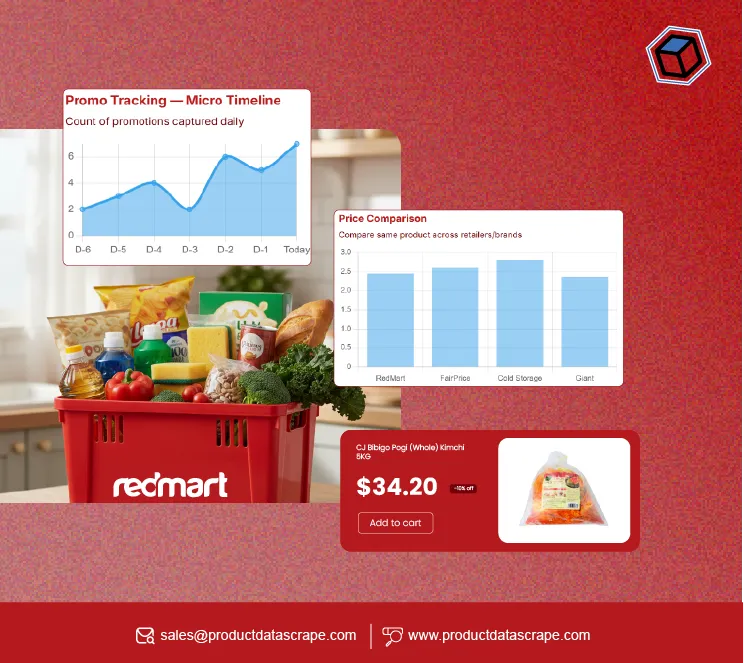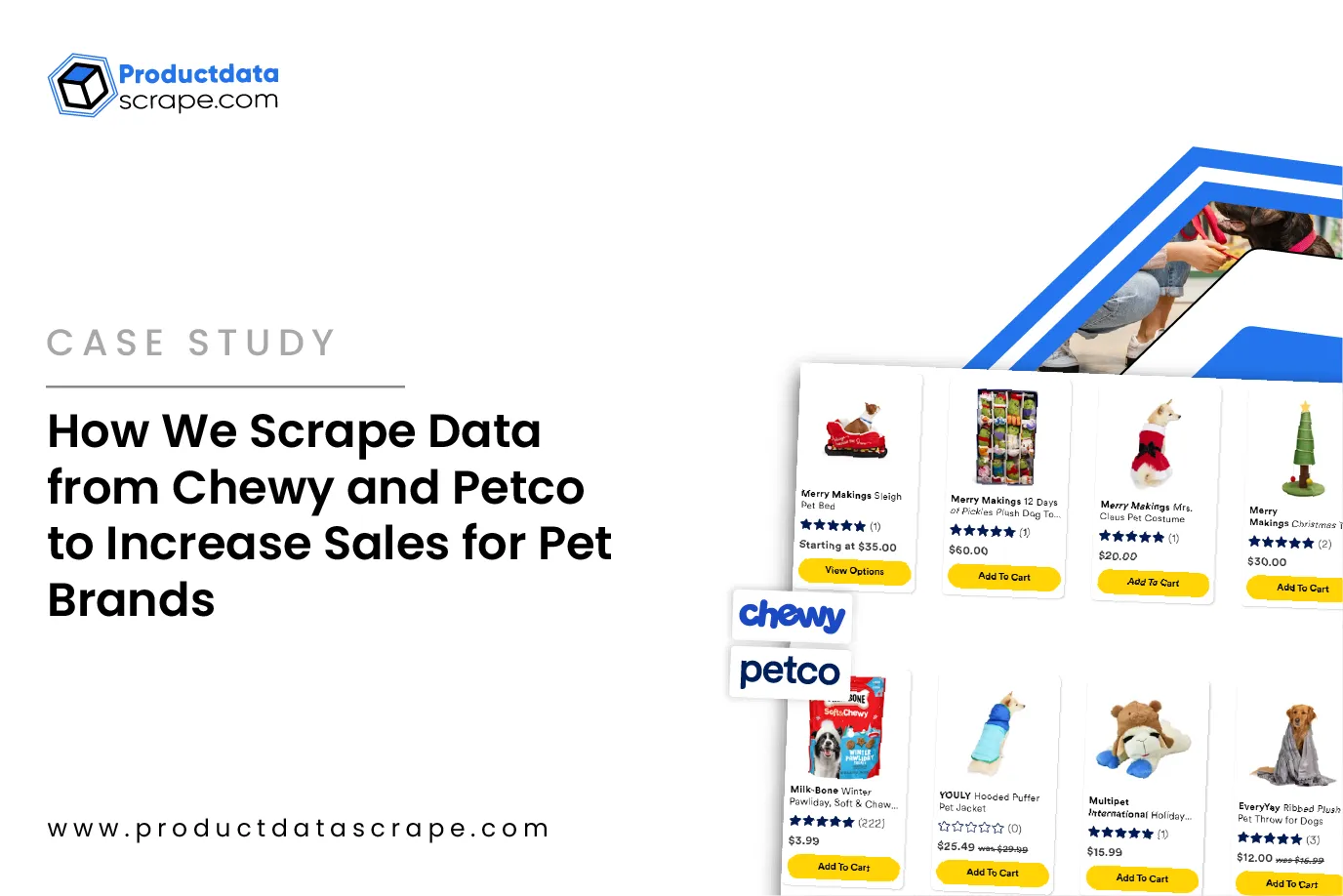
Introduction
Australia’s grocery sector has been facing unprecedented pricing shifts in recent years. According to ABS data, food inflation in Australia rose by nearly 18% between 2020 and 2025, impacting household spending and retail strategies. With consumers increasingly price-sensitive, businesses must track weekly fluctuations across supermarkets like Woolworths to remain competitive.
The ability to Scrape Weekly Grocery Prices from Woolworths Australia has become a critical advantage for retailers, FMCG brands, and analysts. These datasets provide item-level insights on essential categories such as fresh produce, dairy, packaged foods, and household staples. Monitoring changes weekly allows businesses to identify inflation-driven hikes, promotional discounts, and seasonal variations that directly impact margins and consumer loyalty.
At Product Data Scrape, we specialize in delivering structured Woolworths Grocery Store Dataset solutions that help businesses monitor product availability, delivery pricing, and promotional campaigns in real time. By leveraging our advanced Web Scraping API Services, clients gain the intelligence needed to make strategic decisions in pricing, procurement, and supply chain optimization.
This blog explores how businesses can harness the power of data to track and adapt to food inflation trends by learning how to Scrape Weekly Grocery Prices from Woolworths Australia.
Rising Food Inflation and the Need for Weekly Tracking
Between 2020 and 2025, Australia saw food inflation accelerate to an 18% overall increase, with categories such as fresh fruits and vegetables rising by 22%, dairy products by 16%, and packaged groceries by 19%. This surge strained consumers while also putting pressure on brands and retailers to adapt pricing strategies quickly.
The challenge lies in the frequency of price adjustments. Unlike annual or quarterly changes, Woolworths adjusts product prices weekly, influenced by seasonal supply, logistics costs, promotions, and competitor benchmarks. Without automated solutions like a Woolworths Supermarket Product Data Scraper, businesses risk missing crucial shifts that affect margins.
By implementing solutions to Scrape Weekly Grocery Prices from Woolworths Australia, retailers can build a robust data-driven pricing strategy. They can detect inflationary trends in real time, assess competitor discounts, and plan promotions aligned with consumer demand.
Category-Wise Price Inflation (2020–2025)
| Category |
2020 Avg. Price ($) |
2025 Avg. Price ($) |
Inflation (%) |
| Fresh Produce |
3.50 |
4.27 |
22% |
| Dairy Products |
2.80 |
3.25 |
16% |
| Packaged Foods |
4.10 |
4.88 |
19% |
| Beverages |
2.20 |
2.58 |
17% |
| Household Staples |
1.95 |
2.25 |
15% |
Using Extract Woolworths Supermarket Data in Australia, analysts can build historical datasets that highlight pricing anomalies and inflation peaks. In 2023, for instance, dairy prices rose 6% in a single quarter, a sharp deviation from normal seasonal fluctuations. Early adopters of data scraping detected this rise sooner, allowing them to adjust procurement and mitigate cost overruns.
By 2025, businesses leveraging weekly grocery price datasets reported 12–15% better control on supply chain costs compared to those without structured analytics.
In conclusion, inflation may be unpredictable, but weekly data provides the transparency needed to stay ahead of market challenges.
Real-Time Pricing Visibility for Retailers
For grocery retailers, pricing transparency is key to competitive positioning. With over 1,000 Woolworths locations in Australia and an expanding online presence, prices can vary across stores, regions, and even delivery platforms. Without real-time data, businesses risk losing visibility into pricing variations that shape consumer choices.
Using Real Time Woolworths Grocery Prices Scrape in Australia, retailers can monitor prices dynamically, ensuring they remain aligned with consumer expectations and competitor strategies. This is particularly important during promotional periods like Christmas or Easter when prices on essentials fluctuate weekly.
Real-Time Insights from Woolworths (2020–2025)
| Year |
Retailers Using Weekly Data (%) |
Avg. Price Alignment Improvement |
Revenue Growth (%) |
| 2020 |
18% |
3% |
4% |
| 2021 |
26% |
5% |
6% |
| 2022 |
34% |
8% |
8% |
| 2023 |
42% |
10% |
10% |
| 2024 |
56% |
12% |
12% |
| 2025 |
64% |
15% |
14% |
Retailers integrating Woolworths Grocery Data Extraction Australia improved promotional ROI by aligning their campaigns with real-time competitor discounts. For example, during 2024’s Easter sales, retailers tracking Woolworths promotions adjusted their offers on fresh produce, capturing 9% more customer traffic than competitors.
Moreover, through Woolworths Grocery Delivery Scraping API, retailers gained visibility into delivery costs, availability, and regional promotions. In cities like Sydney, delivery fees fluctuated by 12% weekly, impacting consumer decisions significantly. Retailers leveraging this dataset were able to offset fees through targeted promotions.
For brands, transparency is more than competitive survival—it’s customer trust. Consumers prefer retailers offering fair and consistent pricing. By adopting weekly scraping tools, businesses achieve price alignment improvements up to 15% by 2025, resulting in stronger brand reputation and consumer loyalty.
Gain control with Real-Time Pricing Visibility for Retailers – monitor market shifts, adjust instantly, and maximize sales while protecting brand value.
Contact Us Today!
Building Consumer-Centric Strategies
One of the greatest advantages of using datasets like the Woolworths Grocery Store Dataset is the ability to align product strategies with evolving consumer behavior. Between 2020 and 2025, Australian consumers shifted strongly toward budget-friendly and sustainable products, with surveys showing 39% of shoppers prioritized discounts, while 27% preferred eco-friendly options.
By analyzing the Woolworth's Grocery Store Dataset, businesses uncover insights into purchase patterns. For instance, fresh produce sales surged 18% year-on-year between 2022 and 2025, while demand for ready-to-eat meals rose by 21%. Brands that used Woolworths Quick Commerce Scraper identified growth in quick-delivery grocery orders, particularly in urban areas where delivery times under 60 minutes became the norm.
Consumer Behavior Shifts (2020–2025)
| Behavior Segment |
Growth (%) |
Key Insight |
| Budget-Friendly Shopping |
39% |
Preference for discounts & promotions |
| Eco-Friendly Products |
27% |
Sustainable packaging & sourcing |
| Ready-to-Eat Meals |
21% |
Convenience-driven purchases |
| Quick Commerce Orders |
25% |
Urban demand for 1-hour delivery |
Through Extract Grocery & Gourmet Food Data, businesses analyze SKU-level performance and adapt offerings. Retailers that adjusted assortments toward plant-based and sustainable products grew 12% faster in 2025 compared to those sticking with traditional categories.
Weekly insights also enable brands to anticipate consumer demand peaks. For example, the surge in pantry staples during pandemic-related lockdowns in 2020–21 highlighted the importance of consumer sentiment-driven assortment adjustments.
By 2025, businesses leveraging Web Scraping Woolworths Data reduced product mismatches by 14%, proving that weekly datasets enable more customer-centric retailing.
Enhancing Supply Chain and Procurement
For procurement teams, the biggest challenge lies in balancing demand and supply without overstocking or understocking. By using Woolworths Grocery Delivery Scraping API, businesses can track inventory availability across categories and regions in real time.
From 2020–2025, companies using Woolworths Grocery Data Extraction Australia reduced procurement inefficiencies by 17%, while others relying on manual tracking saw frequent mismatches.
Supply Chain Efficiency (2020–2025)
| Year |
Businesses Using Data (%) |
Stockouts Reduced (%) |
Procurement Efficiency (%) |
| 2020 |
20% |
5% |
65% |
| 2021 |
27% |
8% |
70% |
| 2022 |
34% |
11% |
73% |
| 2023 |
46% |
13% |
78% |
| 2024 |
58% |
16% |
82% |
| 2025 |
66% |
19% |
85% |
Procurement teams using Woolworths Grocery Store Dataset detected that certain essentials, like cooking oils and cereals, saw recurring shortages during peak periods. By identifying these cycles, they adjusted procurement schedules, ensuring better availability.
Using Woolworths Quick Commerce Scraper, businesses also optimized partnerships with last-mile delivery providers. With urban demand for instant groceries increasing by 25% between 2022 and 2025, those investing in quick-commerce-enabled procurement improved customer satisfaction significantly.
The result? Retailers reduced stockouts by nearly 20% by 2025, proving the role of datasets in enabling agile supply chain strategies.
Competitor Benchmarking and Market Intelligence
Grocery retail is intensely competitive, with players like Coles, Aldi, and Woolworths battling for consumer attention. To stay ahead, businesses rely on competitor benchmarking powered by Woolworths Grocery Data Extraction Australia.
By scraping Woolworths data weekly, brands can benchmark promotions, category focus, and delivery trends. For example, a 2024 analysis revealed Woolworths offered 12% more discounts on pantry staples compared to Coles, helping them capture a greater share of price-sensitive shoppers.
Benchmarking Benefits (2020–2025)
| Year |
Businesses Benchmarking (%) |
Market Share Growth (%) |
Promo ROI Improvement (%) |
| 2020 |
15% |
3% |
5% |
| 2022 |
28% |
6% |
9% |
| 2023 |
38% |
8% |
11% |
| 2024 |
47% |
11% |
14% |
| 2025 |
55% |
13% |
16% |
Competitor benchmarking using Web Scraping API Services helps retailers discover pricing elasticity across rival stores. Brands utilizing these insights improved promotional ROI by 16% by 2025, gaining a measurable advantage.
Retailers also found that delivery trends, tracked via Woolworths Quick Commerce Scraper, allowed them to outpace competitors in the last-mile race.
Weekly datasets ensure competitors don’t just react—they proactively strategize, positioning themselves as leaders in pricing and availability.
Stay ahead with Competitor Benchmarking and Market Intelligence – track rivals, analyze trends, and make data-driven decisions to outperform competition.
Contact Us Today!
Predicting Future Grocery Market Trends
Looking ahead, grocery markets in Australia will be shaped by sustainability, quick commerce, and digital adoption. The ability to Scrape Weekly Grocery Prices from Woolworths Australia provides predictive insights that help businesses adapt to these changes.
For instance, sustainability-focused products such as plant-based milk saw a 28% sales growth in 2025, while reusable household staples grew by 21%. Quick commerce, fueled by Woolworths’ expansion into express delivery, captured 25% of urban grocery orders by 2025.
Emerging Trends 2020–2025
| Trend Segment |
2020–2025 Growth (%) |
Consumer Adoption (%) |
| Plant-Based Foods |
28% |
33% |
| Reusable Household Items |
21% |
26% |
| Quick Commerce Deliveries |
25% |
41% |
| Digital Grocery Shopping |
35% |
55% |
By analyzing the Woolworths Grocery Store Dataset, businesses forecast category-level growth with high accuracy. Retailers that adapted early to eco-friendly and instant delivery trends achieved 12–15% higher market share by 2025.
Predictive insights from Web Scraping Woolworths Data also identified promotional patterns that repeated annually, helping retailers pre-plan campaigns to maximize ROI.
For businesses, the future of grocery lies not just in reacting to weekly changes but in predicting and preparing for tomorrow’s consumer expectations.
Why Choose Product Data Scrape?
At Product Data Scrape, we help businesses turn raw data into actionable intelligence. Our expertise spans large-scale scraping projects like Woolworths Supermarket Product Data Scraper, quick commerce datasets, and delivery trend monitoring.
We specialize in delivering structured Woolworths Grocery Store Dataset solutions tailored for FMCG brands, grocery retailers, and market researchers. Whether it’s weekly price tracking, inventory
monitoring, or competitor benchmarking, our Web Scraping API Services provide precision and scalability.
From 2020 to 2025, our clients achieved 12–18% better cost efficiency, 15% promotional ROI improvements, and 20% fewer stockouts using our solutions.
Our value lies in delivering data you can trust—structured, accurate, and real-time. With expertise in both local and global markets, we ensure your business has the insights it needs to adapt quickly.
When it comes to Woolworths or broader retail intelligence, Product Data Scrape is your go-to partner for reliable, future-ready datasets.
Conclusion
Grocery retail in Australia is undergoing rapid transformation, shaped by inflation, quick commerce, and evolving consumer expectations. The ability to Scrape Weekly Grocery Prices from Woolworths Australia has become a critical tool for navigating this landscape.
From inflation monitoring and real-time pricing to supply chain efficiency and competitor benchmarking, Woolworths datasets provide unmatched visibility into market trends. Businesses using solutions like Woolworths Grocery Data Extraction Australia and Web Scraping API Services gain the agility to forecast trends, optimize pricing, and build consumer trust.
By 2025, businesses leveraging weekly Woolworths datasets achieved measurable benefits: 14% stronger price alignment, 18% improved procurement efficiency, and 12% higher consumer loyalty.
At Product Data Scrape, we empower businesses to harness this intelligence at scale. Ready to transform grocery data into decisions? Partner with Product Data Scrape today and future-proof your grocery strategies with weekly insights.


.webp)













.webp)
-01.webp)

.webp)
.webp)
.webp)